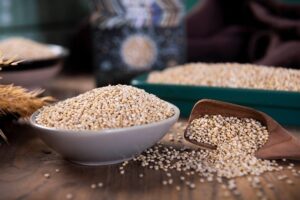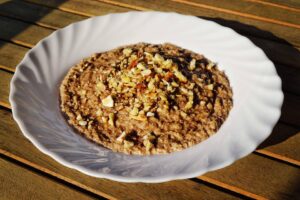Getting to Know Quinoa
go.ncsu.edu/readext?1078831
en Español / em Português
El inglés es el idioma de control de esta página. En la medida en que haya algún conflicto entre la traducción al inglés y la traducción, el inglés prevalece.
Al hacer clic en el enlace de traducción se activa un servicio de traducción gratuito para convertir la página al español. Al igual que con cualquier traducción por Internet, la conversión no es sensible al contexto y puede que no traduzca el texto en su significado original. NC State Extension no garantiza la exactitud del texto traducido. Por favor, tenga en cuenta que algunas aplicaciones y/o servicios pueden no funcionar como se espera cuando se traducen.
Português
Inglês é o idioma de controle desta página. Na medida que haja algum conflito entre o texto original em Inglês e a tradução, o Inglês prevalece.
Ao clicar no link de tradução, um serviço gratuito de tradução será ativado para converter a página para o Português. Como em qualquer tradução pela internet, a conversão não é sensivel ao contexto e pode não ocorrer a tradução para o significado orginal. O serviço de Extensão da Carolina do Norte (NC State Extension) não garante a exatidão do texto traduzido. Por favor, observe que algumas funções ou serviços podem não funcionar como esperado após a tradução.
English
English is the controlling language of this page. To the extent there is any conflict between the English text and the translation, English controls.
Clicking on the translation link activates a free translation service to convert the page to Spanish. As with any Internet translation, the conversion is not context-sensitive and may not translate the text to its original meaning. NC State Extension does not guarantee the accuracy of the translated text. Please note that some applications and/or services may not function as expected when translated.
Collapse ▲Quinoa has become popular in the last ten to 15 years. Or I more correctly should say popular again. It is not a new food. Quinoa has been around for several thousands of years and was a major food crop for pre-Columbian cultures in Latin America.
The word itself comes from Spanish and Quechua (a South American culture.) Quinoa (pronounced KEEN-wah) is a species of goosefoot (Chenopodium) that’s related to beetroots and spinach. In the Quechua language, quinoa is called chisiya, meaning ‘mother grain’.
 People frequently call it “an ancient grain”—but it really is a seed. If you’ve never eaten it, quinoa is a small round seed that looks a lot like millet or couscous or maybe even tapioca. It’s cooked and used like you would use rice, pasta or oatmeal.
People frequently call it “an ancient grain”—but it really is a seed. If you’ve never eaten it, quinoa is a small round seed that looks a lot like millet or couscous or maybe even tapioca. It’s cooked and used like you would use rice, pasta or oatmeal.
You don’t have to go to a specialty food store to buy quinoa. I found it locally in grocery and discount stores. Look in the rice and dry bean section. In the US we can usually find white, red and black quinoa. The white is most common. Red quinoa is a little harder to find and has a nuttier flavor. I’ve found ready-to-cook quinoa and also package mixes already cooked and ready to quickly microwave.
Nutritionally it’s a real powerhouse. Quinoa is considered to be a complete source of plant-based protein, containing all nine essential amino acids. This is great for vegetarians. It’s also gluten-free and contains both soluble and insoluble fiber. Other good things: it’s got iron, magnesium and zinc.
Quinoa is also reasonably low in calories. One cup of cooked quinoa contains approximately 222 calories along with 8 grams of protein and 3.5 grams of fat and 5 grams of fiber. Compare that to the same amount of white rice at 169 calories, 3.5 grams protein, less than one gram unsaturated fat and 1.7 grams fiber.
It’s hard to describe how quinoa tastes. Some folks say it has an “earthy”, grassy or nutty flavor. It is rather bland to me. It seems to pick up the flavors of what it’s cooked with or the sauce added to it. Quite frequently recipes have it cooked with other grains like wild or brown rice, white or jasmine rice or oatmeal.
 It can be eaten hot or cold for breakfast. Add a marinara sauce of dinner. Make a risotto or pilaf as a side dish. Or add to soup. Or a cold salad like one usually made with pasta.
It can be eaten hot or cold for breakfast. Add a marinara sauce of dinner. Make a risotto or pilaf as a side dish. Or add to soup. Or a cold salad like one usually made with pasta.
Here’s a recipe for a cold crunchy quinoa salad that I’ve adapted from Judy Doherty, Chef at Food and Health Communications. She originally used red quinoa but any quinoa will work. I like the flavor of toasted sesame oil with the bland quinoa. Chef Judy used pomegranate seeds as the fruit, but I’ve added a North Carolina twist by using blueberries. Any berry or fruit would work. I eat this salad as a main dish, a side dish or a snack.
Cook the quinoa as directed on the package. It is typically prepared on top of the stove, but I have been successful using my rice cooker. The ratio is usually one-part quinoa to two parts liquid. One cup raw makes about three cups cooked. One curious thing. You can tell it’s cooked when it becomes somewhat translucent and a white ring appears along the outside edge of the seed. At closer look it appears to be a little sprout. This is the seed germ. It’s OK to eat.
Quinoa and Berry Salad
- 3 cups cooked quinoa, cooled slightly
- 1-3 teaspoons sesame oil
- 1 ½ – 2 Tablespoons lemon juice
- 1 cup celery, chopped
- 1 cup blueberries or other berries
- ½ cup seedless raisins
- ¼- ½ cup chopped roasted almonds
Combine the cooked quinoa with the sesame oil and the lemon juice and then mix in remaining ingredients. Chill before serving.
Resources
Syracuse is a Family and Consumer Science team member and can be reached clsyracu@ncsu.edu or by calling at N.C. Cooperative Extension, Brunswick County Center 910-253-2610.



